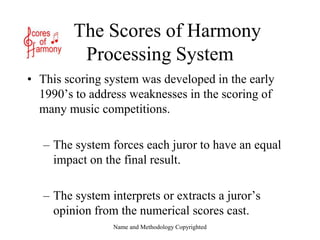
International Tchaikovsky Competition Voting System
- 1. Name and Methodology Copyrighted The Scores of HarmonyProcessing System This scoring system was developed in the early 1990’s to address weaknesses in the scoring of many music competitions. The system forces each juror to have an equal impact on the final result. The system interprets or extracts a juror’s opinion from the numerical scores cast.
- 2. Name and Methodology Copyrighted The Scores of HarmonyProcessing System The system minimizes the impact of “gaming” by a juror. The system permits abstentions while minimizing any resulting bias. The system removes the effect of strong juror personalities which could impact the results from traditional consensus systems.
- 3. Name and Methodology Copyrighted The First Processing Step The first step is to shift each juror’s scores so that each juror’s score set has the same mean (average) of 12.5 on a scale from 0 to 25. This step helps eliminate imbalance of influence if one juror uses all high numbers and another uses all low numbers.
- 4. Name and Methodology Copyrighted The First Processing Step This graphic displays a hypothetical shift of a single juror’s score set. Mean = 12.5 Mean = 18 Juror Raw Score Distribution Same Juror After Shifting
- 5. Name and Methodology Copyrighted A Numerical Definition of Opinion Think of each juror having a certain amount of money to spend as opinion through the voting. We want to assure that each juror spends the same amount of money, or expresses the same amount of opinion. Do not think of a juror’s scores as the money. Instead, think of the relative spacing of the juror’s scores as the money that is spent. Relative spacing of scores expresses opinion. The program measures the spacing or spread of a single juror’s scores using the standard deviation of that juror’s scores: Standard Deviation = Square Root ( Sum(xj – mean)2 / (N-1)) where the sum is over all “N” musicians being judged.
- 6. Name and Methodology Copyrighted Comments on the Standard Deviation of a Distribution The standard deviation measures the amount of spread (or size of the spaces) in a data distribution. If much data is far from the average or mean (either high or low scores), then the standard deviation will be high If much data is very near the average or mean, then the standard deviation will be low
- 7. Name and Methodology Copyrighted The Second Processing Step Each juror’s scores are expanded or contracted like an accordion (centered on the mean score) so that each juror’s modified score set possesses the same “pre-selected” standard deviation. By adjusting a juror’s scores to exhibit a “pre-selected” standard deviation, a limit is placed on the total spread of the juror’s scores and the amount of opinion the juror can express. This creates a balanced situation in which each juror contributes the same amount of opinion to the final decision process.
- 8. Name and Methodology Copyrighted The Second Processing Step This graphic shows a sample of adjusting the standard deviation of a juror’s score set. Juror Before Step 2 The Same Juror After Step 2
- 9. The Practical Effects of Step 2 A juror can indeed give a few very high scores or a few very low scores, and these scores will carry great significance. If a juror initially gives many high scores or many low scores, the impact will be diluted through the imposition of the fixed standard deviation in Step 2. . Name and Methodology Copyrighted
- 10. Name and Methodology Copyrighted The Definition ofa Rogue Score A rogue score for a musician is a score that is significantly inconsistent with the opinion of the jury as a whole. The score is either far too high or far too low, thus making it a statistical outlier from the other scores for that musician. To identify rogue scores, the program first computes the standard deviation of the scores received by a single musician centered on the median score received. A rogue score is usually defined to be a score lying further than three standard deviations away from the median score for that musician.
- 11. Name and Methodology Copyrighted The Third Processing Step For each musician, the program identifies the rogue scores by the process outlined on the previous slide. The program then adjusts the rogue scores towards the median until they are +/- 3 standard deviations from the median. When working with the full scoring range of 0 to 25, this 3 standard deviation distance is chosen to be 5.0, or 20% of the full scale.
- 12. Name and Methodology Copyrighted The Fourth Processing Step At this stage, the program averages the scores for each musician, considering only the scores of non-abstaining jurors. The program ranks the contestants accordingly.
- 13. Mathematical Details of the Standard Deviation Standard deviation is a widely used measure of the variability or dispersion. It shows how much variation there is from the "average" (mean). A low standard deviation indicates that the data points tend to be very close to the mean, whereas high standard deviation indicates that the data are spread out over a large range of values. Name and Methodology Copyrighted
- 14. Mathematical Details of the Standard Deviation The mean and the standard deviation of a set of data are usually reported together. In a certain sense, the standard deviation is a "natural" measure of statistical dispersion if the center of the data is measured about the mean. This is because the standard deviation from the mean is smaller than from any other point. The precise statement is the following: suppose x1, ..., xn are real numbers and define the function: Using calculus or completing the square, it is possible to show that σ(r) has a unique minimum at the mean This formula is used twice in the program, once with r = the mean and once with r = the median. Name and Methodology Copyrighted
